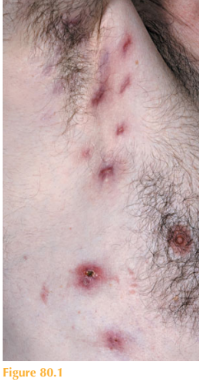History
A 54-year-old man with a 1-year history of mul-
tiple skin boils is seen in the dermatology clinic.
These had started within two months of returning
from India. The lesions first appeared as small red nodules, which increased in size and became pain-ful before discharging pus. The lesions seemed to heal slowly, leaving scars. New lesions would then appear every few weeks. He has taken numerous courses of antibiotics from his GP, which seemed partially helpful, and has required incision and drainage of some of the larger, more painful furun-cles. His wife, who is a nurse working in the local orthopaedics department, does not have any skin problems. The patient has a history of inflammatory bowel disease but is otherwise well and not taking any regular medications.
Examination
Multiple actively discharging boils and furuncles are seen on the right side of his chest with scarred areas from healed lesions (Fig. 80.1). He has a few boils elsewhere: on his left hip, and neck. There are pal-pable lymph nodes in the right axilla. Examination is otherwise unremarkable and his temperature is 37 oC.


Questions
• What organism is most likely the cause of his boils?
• Why might the boils not clear up with conventional systemic antibiotics?
• What special microbiological test would you request?
Recurrent recalcitrant boils caused by the bacterium Staphylococcus aureus are usually seen in young to middle-aged adults. Conventional treatment of large/painful furuncles is incision and drainage with 2 weeks of oral antibiotics. This patient, however, did not respond to this traditional approach. Pus from the active boils taken by the GP cultured methicillin-resistant Staphylococcus aureus (MRSA) – this was a hospital-acquired rather than the community-acquired type of MRSA.
Subsequently, swabs were taken in the dermatology department from the active lesions as well as his carrier sites and sent to the microbiology department with a special request for gene detection studies to look for S. aureus with the virulence factor Panton Valentine leukocidin (PVL). Microbiology results showed the patient to have MRSA and PVL-positive S. aureus in the boils and up his nose.
PVL is a virulence factor that is acquired by certain strains of S. aureus rendering them difficult to kill by conventional antibiotic treatment regimens. Not all strains that are PVL-positive are also resistant. In fact most are fully sensitive to methicillin; however bacteria that are resistant and virulent are very recalcitrant clinically and therapeutically, as in this case.
This patient may have acquired his PVL-positive S. aureus whilst travelling in India –travel is a risk factor for acquiring this virulent strain, as are contact sports and keeping pets. There was no direct evidence that the patient acquired the bacteria from his wife (who worked in hospitals) as her swabs were all negative. Nonetheless there is evidence that PVL-positive strains of S. aureus are also highly transmissible and this is thought to play a role in multiple family/team members being simultaneously affected.
Treatment for PVL-positive S. aureus is similar to treatment for MRSA, in that patients require decontamination therapy alongside systemic antibiotics. This patient was treated with nasal mupirocin three times a day for 5 days up each nostril. He was asked to wash daily with Hibiscrub (4% chlorhexidine). He was asked to take rifampicin and clindamy-cin 300 mg twice daily for 10 weeks. All the lesions healed and no new lesions appeared.
Follow-up swabs from all sites were negative.
In patients with PVL-positive S. aureus that is fully sensitive to methicillin, a prolonged course of high-dose flucloxacillin plus decontamination may be sufficient to clear the infection. Asymptomatic family members should be swabbed, and if found to be positive at their carrier sites should also undergo decontamination.
KEY POINTS
• Consider virulent strains of Staphylococcus aureus in patients with severe or recurrent boils.
• Ask your microbiologist to undertake special gene detection tests on S. aureus isolates to look for PVL.
• Patients should undertake decontamination with nasal antibiotic, antiseptic wash and prolonged courses of systemic antibiotics.
need an explanation for this answer? contact us directly to get an explanation for this answer